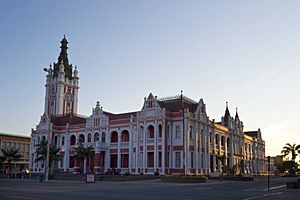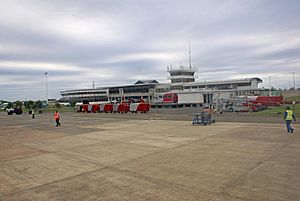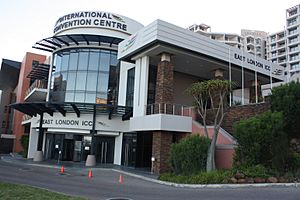East London, South Africa facts for kids
Quick facts for kids
East London
|
|
|---|---|

East London, looking toward the sea
|
|
| Country | |
| Province | |
| Municipality | Buffalo City |
| Established | 1847 |
| Area | |
| • City | 168.86 km2 (65.20 sq mi) |
| • Metro | 2,536 km2 (979 sq mi) |
| Population
(2011)
|
|
| • City | 267,007 |
| • Density | 1,581.23/km2 (4,095.37/sq mi) |
| • Metro | 755,200 |
| • Metro density | 297.79/km2 (771.28/sq mi) |
| Racial makeup (2011) | |
| • Black African | 70.1% |
| • Coloured | 11.6% |
| • Indian/Asian | 1.8% |
| • White | 16.0% |
| • Other | 0.5% |
| First languages (2011) | |
| • Xhosa | 61.8% |
| • English | 21.2% |
| • Afrikaans | 13.3% |
| • Other | 3.8% |
| Time zone | UTC+2 (SAST) |
| Postal code (street) |
5200
|
| PO box |
5201–5499
|
| Area code | 043 |
East London (called eMonti in Xhosa and Oos-Londen in Afrikaans) is a vibrant city on the southeastern coast of South Africa. It's part of the Buffalo City Metropolitan Municipality in the Eastern Cape Province. This city is special because it sits right on the Indian Ocean coast, between the Buffalo River and the Nahoon River. It's also home to South Africa's only river port, which is a port located on a river instead of directly on the open sea. In 2011, East London had over 267,000 people living there, with more than 755,000 in the wider metropolitan area.
Contents
- Discovering East London's Past
- East London's Geography and Weather
- People and Languages of East London
- East London's Economy
- Neighborhoods of East London
- Sports and Recreation in East London
- Education in East London
- Places to Visit in East London
- Getting Around East London
- Famous People from East London
- Images for kids
Discovering East London's Past
How East London Began
The city of East London started thanks to a man named John Bailie. He was one of the 1820 Settlers from Britain. In 1836, he explored the mouth of the Buffalo River and decided it was a good spot for a town. You can still find a memorial on Signal Hill that remembers this event.
The town was first called Port Rex because of its unique river port. Later, it was renamed London to honor the capital city of the United Kingdom. That's why it's called East London today! The small settlement on the West Bank grew over time and became a city in 1914.
Forts and Early Settlers
In the mid-1800s, there were conflicts between the British settlers and the local Xhosa communities. East London became an important supply port for the military headquarters in King William's Town, which was about 50 kilometers away.
A British fort, called Fort Glamorgan, was built on the West Bank in 1847. It was then added to the Cape Colony. This fort was one of many British forts built in the border area, which became known as British Kaffraria.
As the port grew, more people settled in East London. Many German settlers arrived, and they were responsible for naming some nearby towns like Stutterheim and Berlin. Even today, you'll find German surnames in East London, but most of their descendants now speak English.
Growing the City with New Infrastructure
The port at the mouth of the Buffalo River started operating in 1870. In 1872, the Cape Colony gained some independence from Britain. Its first Prime Minister, John Molteno, helped combine three nearby settlements to form the main part of East London in 1873.
Soon after, in 1876, construction began on the region's railway lines and the East London harbor. These new projects helped the area grow quickly into the busy city we know today.
A very unique double-decker bridge was finished over the Buffalo River in 1935. It's still the only bridge of its kind in South Africa! East London also has interesting places like the Gately House, City Hall, and the East London Museum. The museum is famous for housing a coelacanth, a prehistoric fish that was thought to be extinct until it was found alive near East London in 1938.
East London After Apartheid
After the end of apartheid in 1994, East London became part of the Eastern Cape province. In 2000, East London joined the Buffalo City Metropolitan Municipality, which also includes Qonce, Bhisho, and Mdantsane. East London is the main center for this metropolitan area.
East London's Geography and Weather
| Weather chart for East London | |||||||||||||||||||||||||||||||||||||||||||||||
|---|---|---|---|---|---|---|---|---|---|---|---|---|---|---|---|---|---|---|---|---|---|---|---|---|---|---|---|---|---|---|---|---|---|---|---|---|---|---|---|---|---|---|---|---|---|---|---|
| J | F | M | A | M | J | J | A | S | O | N | D | ||||||||||||||||||||||||||||||||||||
|
69
26
18
|
92
26
19
|
105
25
18
|
83
24
15
|
52
23
13
|
40
21
11
|
47
21
10
|
78
21
11
|
80
21
12
|
102
22
14
|
110
23
16
|
63
25
17
|
||||||||||||||||||||||||||||||||||||
| temperatures in °C precipitation totals in mm source: SAWS |
|||||||||||||||||||||||||||||||||||||||||||||||
|
Imperial conversion
|
|||||||||||||||||||||||||||||||||||||||||||||||
East London has an oceanic climate, which means it has mild temperatures like many coastal areas. It doesn't have a truly dry season, but winters are a bit drier. The wettest times are spring and autumn.
The coldest temperature ever recorded was 3 degrees Celsius, and the hottest was 44 degrees Celsius on March 13, 2021. Sometimes, very hot winds called berg winds can cause temperatures to rise quickly. Even though it rarely freezes, East London has seen snow twice, in 1985 and 1989.
| Climate data for East London (1991–2020, extremes 1939–1990) | |||||||||||||
|---|---|---|---|---|---|---|---|---|---|---|---|---|---|
| Month | Jan | Feb | Mar | Apr | May | Jun | Jul | Aug | Sep | Oct | Nov | Dec | Year |
| Record high °C (°F) | 36.4 (97.5) |
42.6 (108.7) |
44.0 (111.2) |
35.9 (96.6) |
37.0 (98.6) |
32.8 (91.0) |
34.3 (93.7) |
37.5 (99.5) |
41.7 (107.1) |
40.9 (105.6) |
40.3 (104.5) |
38.2 (100.8) |
44.0 (111.2) |
| Mean daily maximum °C (°F) | 25.9 (78.6) |
26.3 (79.3) |
25.5 (77.9) |
24.0 (75.2) |
23.2 (73.8) |
21.9 (71.4) |
21.5 (70.7) |
21.6 (70.9) |
21.6 (70.9) |
22.4 (72.3) |
23.4 (74.1) |
24.7 (76.5) |
23.5 (74.3) |
| Daily mean °C (°F) | 22.1 (71.8) |
22.5 (72.5) |
21.5 (70.7) |
19.6 (67.3) |
18.0 (64.4) |
16.3 (61.3) |
15.9 (60.6) |
16.3 (61.3) |
17.0 (62.6) |
18.2 (64.8) |
19.4 (66.9) |
21.0 (69.8) |
19.0 (66.2) |
| Mean daily minimum °C (°F) | 18.3 (64.9) |
18.7 (65.7) |
17.5 (63.5) |
15.1 (59.2) |
12.8 (55.0) |
10.7 (51.3) |
10.2 (50.4) |
11.0 (51.8) |
12.3 (54.1) |
14.0 (57.2) |
15.3 (59.5) |
17.2 (63.0) |
14.4 (57.9) |
| Record low °C (°F) | 9.0 (48.2) |
11.0 (51.8) |
10.3 (50.5) |
7.2 (45.0) |
4.4 (39.9) |
2.6 (36.7) |
1.8 (35.2) |
3.1 (37.6) |
5.0 (41.0) |
5.9 (42.6) |
8.5 (47.3) |
8.4 (47.1) |
1.8 (35.2) |
| Average precipitation mm (inches) | 89 (3.5) |
72 (2.8) |
93 (3.7) |
89 (3.5) |
39 (1.5) |
32 (1.3) |
42 (1.7) |
55 (2.2) |
56 (2.2) |
81 (3.2) |
98 (3.9) |
76 (3.0) |
822 (32.4) |
| Average precipitation days (≥ 1.0 mm) | 9.0 | 8.2 | 8.2 | 7.4 | 3.6 | 2.9 | 3.3 | 5.0 | 5.3 | 8.1 | 8.9 | 9.0 | 79 |
| Average relative humidity (%) | 80 | 82 | 82 | 78 | 72 | 66 | 67 | 71 | 77 | 78 | 80 | 80 | 76 |
| Mean monthly sunshine hours | 221.3 | 203.8 | 212.6 | 210.1 | 224.9 | 223.5 | 229.3 | 238.3 | 221.3 | 211.5 | 211.8 | 214.4 | 2,622.8 |
| Source 1: NOAA (humidity 1961-1990), Deutscher Wetterdienst (extremes) | |||||||||||||
| Source 2: South African Weather Service | |||||||||||||
People and Languages of East London
East London is the second-largest city in the Eastern Cape province. In 2016, its population was about 474,000 people. The most common language spoken in the city is English, followed by Xhosa.
| Gender | Population |
|---|---|
| Male | 140,505 |
| Female | 155,400 |
| Race | Population |
|---|---|
| Black African | 211,581 |
| White | 42,780 |
| Coloured | 35,090 |
| Asian | 4,732 |
| Other groups | 1,632 |
| Languages | Population |
|---|---|
| Xhosa | 179,600 |
| English | 54,504 |
| Afrikaans | 34,742 |
| Sign Language | 1,680 |
| Zulu | 1,663 |
| Sotho | 1,234 |
| Ndebele | 869 |
| Tswana | 618 |
| Northern Sotho | 558 |
| Tsonga | 379 |
| Venda | 168 |
| Other languages | 3,200 |
East London's Economy
East London is an important industrial center in the Eastern Cape. The motor industry is a major employer here. A large Daimler plant, which makes Mercedes-Benz cars and other vehicles, is located near the harbor. These vehicles are sold locally and also exported to places like the United States and Brazil. Other important industries include clothing, textiles, pharmaceuticals, and food processing.
The harbor in East London has seen a lot of investment recently, especially from companies like Daimler AG. This has led to the development of a new car terminal, which helps with exporting vehicles.
To encourage more businesses to invest in East London, the East London Industrial Development Zone (IDZ) was created in 2004. It's located on the West Bank, close to both the port and the airport. This area offers special benefits to businesses, making it an attractive place for new industries to set up.
Neighborhoods of East London
East London is made up of many different neighborhoods, each with its own character. Some of these include:
- Quigney
- Abbotsford
- Southernwood
- Belgravia
- Amalinda
- Winchester
- Chiselhurst
- Beacon Bay
- Berea
- Arcadia
- North End
- Beaconhurst
- Nahoon
- Stirling
- Woodleigh
- Bunkers Hill
- Bonnie Doon
- Vincent
- Baysville
- Selborne
- Cambridge
- Morningside
- Saxilby
- Braelyn
- Duncan Village
- Parkridge
- Parkside
- Peffersville
- Buffalo Flats
- Bebelele
- Gately
- West Bank Village
- Brookville
- Sunnyridge
- Rosemount
- Fullers Bay
- Siyakha
- Collondale
- Willow Park
- Gompo
- Haven Hills
- Highway Gardens
- Scenery Park
- Wilsonia
- Dorchester Heights
- Quenera
- Gonubie
- Mdantsane
- Potsdam
- Fort Jackson
Sports and Recreation in East London
East London is a great place for sports lovers!
Cricket
Cricket is very popular here. The local team, the Warriors, plays in the top provincial competition. Famous cricketers like Mark Boucher, who holds a world record for wicketkeeping, come from East London. The Buffalo Park Stadium in East London has even hosted matches for the ICC Cricket World Cup and the 2009 Indian Premier League.
Running and Marathons
The Buffalo Road Running Club organizes two famous events. One is the Old Mutual Buffalo 42.2 km marathon, held every year. The other is South Africa's oldest 160 km extreme ultra marathon, called the Washie. This challenging race goes along a beautiful coastal route from Port Alfred to East London.
Triathlon
Triathlon is also a big sport here. East London used to host the world-famous Ironman 70.3 South African event every January. This event involves a 1.9 km swim, a 90 km bike ride, and a 21.1 km run. It started and finished at Orient Beach. However, the event moved to Mossel Bay in 2021.
Rugby
Rugby is a favorite sport in East London. The local team, the Border Bulldogs, plays in the Currie Cup. Most big rugby games are held at the Buffalo City Stadium, which can hold about 15,000 people. This stadium was even a host for the 1995 Rugby World Cup. Many talented rugby players, like André Vos and Mark Andrews, started their careers in East London schools.
Motocross
Motocross is also popular, with many national events held in the challenging terrain around East London and Transkei. The ELMCC (East London Motor Cycle Club) organizes most of these exciting motorcycle events.
Motor Racing
East London is home to the Prince George Race Circuit, also known as the East London Grand Prix Circuit. This historic motor racing track opened in 1959 and hosted three Formula One South African Grand Prix races in the 1930s and 1960s. Jody Scheckter, South Africa's only Formula One World Drivers' Champion, began his racing journey on this very track.
Golf
Golf is another popular activity. The East London Golf Club is a highly respected championship course. Other golf clubs in the area include West Bank Golf Club and Gonubie Golf Club. East London has also hosted the Africa Open tournament many times.
Rowing
Rowing takes place on the Buffalo River. The annual Buffalo Regatta, which started in 1881, is the largest in South Africa. In 2018, over 1,000 competitors took part in 200 events over three days.
Surfski and Surfing
Surfski is perfect for East London's coast. The Port Elizabeth to East London Challenge is a tough 244 km race that happens every two years, attracting competitors from all over the world. It started in 1972 as a challenge between a runner and a surf lifesaver to see who was faster.
Surfing is also a big deal in East London. It's home to some of South Africa's best surfers, including Greg Emslie and Zoe Steyn. Nahoon Reef, in the Nahoon suburb, is a famous South African surf spot and hosts the annual Nahoon Surf Pro. The city has also hosted the South African Surfing Championships and even the ISA World Surfing Championship.
Education in East London
East London has many excellent schools and universities.
Secondary Education
- Clarendon High School for Girls
- Hudson Park High School
- Port Rex Technical High School
- Selborne College
- Stirling High School
- West Bank High School
Tertiary Education
- University of Fort Hare
- Walter Sisulu University
- University of South Africa (Unisa)
There are also several private colleges for further studies.
Places to Visit in East London
If you're looking for interesting places to visit in East London, here are a few:
- East London Museum
- Inkwenkwezi Private Game Reserve
- Amathole Museum
- Hood Point Lighthouse
- East London Coast Nature Reserve
Getting Around East London
East London has good transport links to other parts of South Africa.
Roads
Two main national roads serve East London:
- The coastal N2 highway connects it to Qonce, Makhanda, Gqeberha, and Cape Town to the west, and Mthatha and Durban to the east.
- The N6 runs north from East London, going through Komani and Aliwal North to Bloemfontein.
There are also other important routes like the R102, R72, and R346. Within the city, you'll find Metropolitan (or M) routes for major roads.
Rail
The East London railway station offers train services for passengers traveling long distances to Cape Town and Johannesburg. There are also local train services.
Air Travel
King Phalo Airport is the commercial airport for East London. It has flights to other big cities in South Africa.
Famous People from East London
Many talented people have come from East London, including:
- Mark Andrews, rugby player
- Masali Baduza, actress
- Wendy Botha, four-time world surfing champion
- Mark Boucher, international cricketer
- Vuyani Bungu, boxer
- Norman Catherine, artist
- Marjorie Courtenay-Latimer, museum curator who discovered the living coelacanth fish
- Colin Cowie, Hollywood events planner
- Hlomla Dandala, actor and television personality
- Ernie Els, international golfer
- Allan Gray, investor and philanthropist
- Joan Harrison, swimmer and 1952 Olympic champion
- Rory Kockott, rugby player
- Makazole Mapimpi, 2019 & 2023 Rugby World Cup winner
- Msaki, singer-songwriter and composer
- Welcome Ncita, boxer
- Tats Nkonzo, comedian
- Makhaya Ntini, test cricketer for South Africa
- Soso Rungqu, actress
- Jody Scheckter, racing driver and Formula One World Drivers' Champion in 1979
- Jonty Skinner, swimmer and US swimming coach
- André Vos, rugby player
- Zahara, musician
- Jahmil X.T. Qubeka, film director
Images for kids









